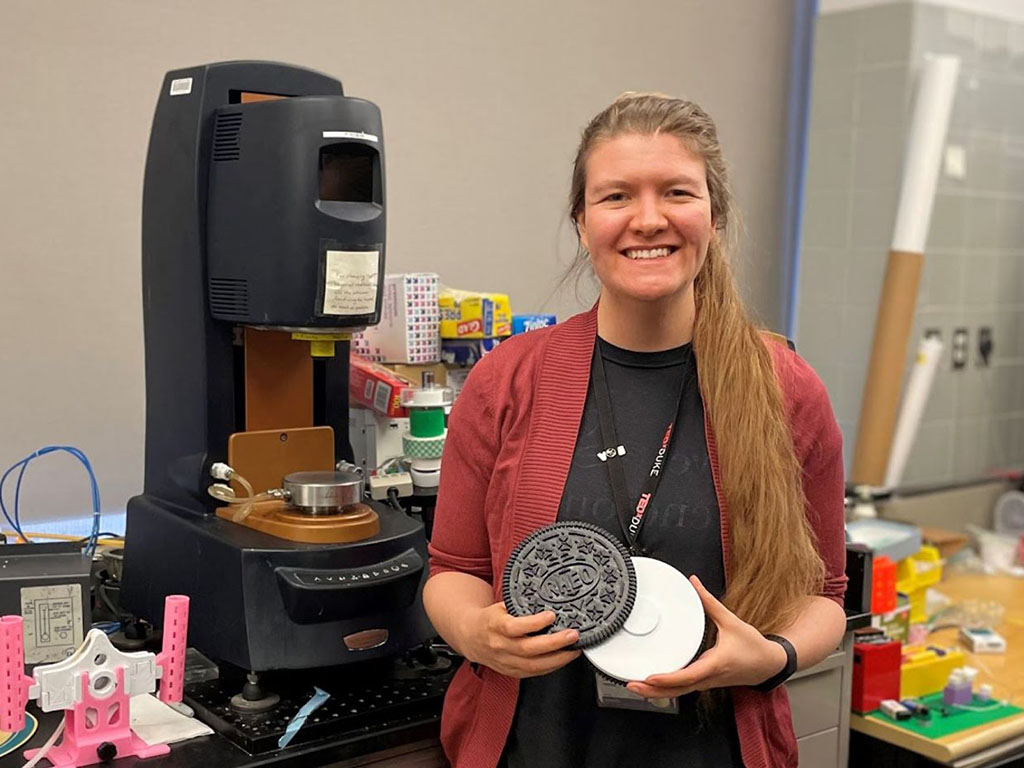MIT Scientists Twist Apart More Than 1,000 Oreos in Search for Perfect Method
Team aimed to solve frustrating problem of getting creme to stick to both wafers
“I’ve always been annoyed that I have to twist them apart and then push creme from one side onto the other,” said Crystal Owens, a Ph.D. candidate in MIT’s mechanical engineering department.
She led a group of researchers on a quest to figure out if there was a trick to getting the creme to glom onto both halves.
Usually, Ms. Owens studies materials that could be used as ink for 3-D printing, squishing them between two counter-rotating metal plates in a device known as a rheometer to study how the fluids deform and respond to torsion, or twisting forces.
One day during the Covid-19 lockdown in 2021, she said, “we just kind of realized that this is a perfect analogy for what happens when you try to twist open an Oreo.”
So she and her colleagues set out to discover if there was a solution to the cookie conundrum.
In a recent study, they glued Oreos of various flavors to the rheometer, then twisted them at different speeds. Materials with similar mechanical properties to Oreo creme—toothpaste, yogurt, ice cream—split down the middle when subjected to enough torsion, Ms. Owens said.
After putting more than 1,000 Oreos to the test, the researchers discovered that the fickle filling stuck to just one wafer about 80% of the time.
And the speed of the twisting didn’t matter. Even at the rheometer’s slowest twisting speed, which took about five minutes to separate the halves, the creme stayed on one side. At the maximum speed—about 100 times faster than a person can twist—the creme flew off both halves, Ms. Owens said.
“We also tested the cookies by hand—twisting, peeling, pressing, sliding and doing other basic motions to get an Oreo apart,” she said. “There was no combination of anything that we could do by hand or in the rheometer that changed anything in our results.”
That suggests the creme is stronger than it is sticky, so is more likely to stay together than adhere to the wafer.
She and her colleagues published their findings last April in the peer-reviewed journal Physics of Fluids. In their paper, they shared suggestions on how Oreo, which is owned by one of the world’s largest snacks companies, Mondelēz International, could tweak production to address the issue.
One idea was to flip the wafers so that the more textured outside surface, which contains the word Oreo, would face inward, said Max Fan, an undergraduate in MIT’s department of mechanical engineering and co-author of the study.
Another was to attach both wafers simultaneously to a blob of creme. Ms. Owens and her colleagues think that the wafer to which the filling is applied first has a tighter bond to the creme.
The company declined to share specifics on the Oreo manufacturing process, but Ms. Deignan said that Oreo “loved this data-informed creativity.”
Thomas Schlathölter, a physicist at the Netherland’s University of Groningen who wasn’t involved in the study, had his university students try to replicate the MIT team’s results with Dutch Oreos. They twisted by hand, which may have affected the outcome, he said.
“To my surprise, many students observed a pretty even splitting of the filling,” Dr. Schlathölter said. “European Oreos seem to be different.” He thinks the difference is in the creme formula.
MIT’s Ms. Owens said she suspects the manufacturing process is different in Europe, not the recipe. Oreo’s Ms. Deignan had no explanation for the differing results.
Oreos are sold in more than 100 countries, and social media is filled with opinions about how best to eat them. One YouTube video with more than 13 million views, called “you’re eating Oreos WRONG”, shows a woman skewering the creme with a fork and drowning it in milk. Others involve using straws as pipettes to get the creme soggy.
Ms. Owens said she is looking to apply the same study concept to other snack foods, such as macarons, ice cream sandwiches and Nutter Butter cookies.
The Oreo research, she said, was a fun, easy way to make her regular physics and engineering work more accessible to the general public. She and Mr. Fan developed a simpler rheometer to test the cookies, which they dubbed an “Oreometer,” that people can 3D-print at home. It uses rubber bands and pennies to twist apart the cookie.
“For me this all started as a personal question,” Ms. Owens said. “But I guess everyone else was also thinking like, ‘Oh, let’s understand my Oreos better.’ ”
This article has been reposted from The Wall Street Journal. https://www.wsj.com/articles/oreo-cookies-twist-creme-mit-scientists-ce6a3daa?st=4wsg34au8ui01a0&reflink=desktopwebshare_permalink
